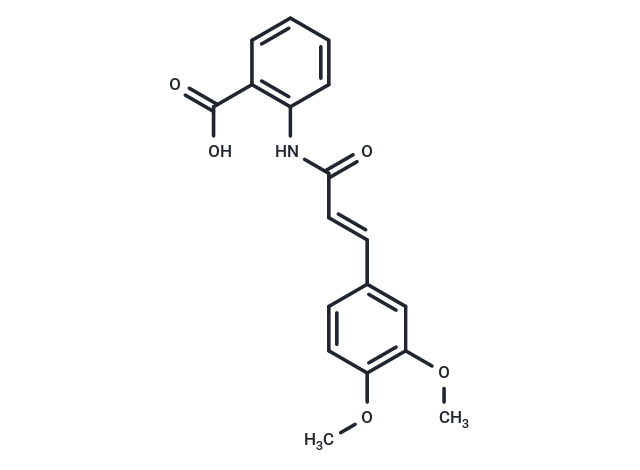Shopping Cart
- Remove All
 Your shopping cart is currently empty
Your shopping cart is currently empty

Trans-Tranilast is an antiallergic drug developed by Kissei Pharmaceuticals. It was approved in 1982 for use in Japan and South Korea for bronchial asthma. Indications for keloid and hypertrophic scar were added in 1993. It has been used for the treatment of allergic disorders such as asthma, allergic rhinitis and atopic dermatitis.

| Pack Size | Price | Availability | Quantity |
|---|---|---|---|
| 5 mg | $32 | In Stock | |
| 10 mg | $52 | In Stock | |
| 25 mg | $89 | In Stock | |
| 50 mg | $142 | In Stock | |
| 100 mg | $212 | In Stock | |
| 200 mg | $313 | In Stock | |
| 1 mL x 10 mM (in DMSO) | $35 | In Stock |
| Description | Trans-Tranilast is an antiallergic drug developed by Kissei Pharmaceuticals. It was approved in 1982 for use in Japan and South Korea for bronchial asthma. Indications for keloid and hypertrophic scar were added in 1993. It has been used for the treatment of allergic disorders such as asthma, allergic rhinitis and atopic dermatitis. |
| Alias | Tranilast trans- |
| Molecular Weight | 327.33 |
| Formula | C18H17NO5 |
| Cas No. | 70806-55-2 |
| Smiles | N(C(/C=C/C1=CC(OC)=C(OC)C=C1)=O)C2=C(C(O)=O)C=CC=C2 |
| Relative Density. | 1.299 g/cm3 (Predicted) |
| Storage | Powder: -20°C for 3 years | In solvent: -80°C for 1 year | Shipping with blue ice. | |||||||||||||||||||||||||||||||||||
| Solubility Information | DMSO: 60 mg/mL (183.3 mM), Sonication is recommended. | |||||||||||||||||||||||||||||||||||
Solution Preparation Table | ||||||||||||||||||||||||||||||||||||
DMSO
| ||||||||||||||||||||||||||||||||||||

Copyright © 2015-2025 TargetMol Chemicals Inc. All Rights Reserved.